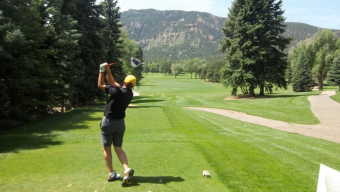COLORADO SPRINGS – The first clue that I was in for a different kind of golf experience came from Ray at the starter’s house.
“Remember gentlemen,” Ray said, “the law of gravity still applies.”
I’ve heard a lot of advice from starters over the years – that putts break toward the desert, or the ocean, or Farmer Smith’s cornfield – but I’ve never had anyone toss out some Sir Isaac Newton.
Okaaaay, so putts will break downhill. Is there something about that theory that I am missing?
Eighteen holes later, I realized what Ray was talking about. Putts that look downhill appear to break uphill. Putts that look uphill can be lightning fast.
That’s life at the Broadmoor, where golf is a supreme challenge but you’re pampered before and after your round.
The Broadmoor is one of the world’s great resorts, a Five-Star, Five-Diamond facility nestled in the shadow of Pike’s Peak with stunning scenery and customer service that makes you feel like the most important person on the property.
Then you get onto one of the three golf courses – the East, West and Mountain – and they will beat you up if you forget that basic principle – all things roll downhill.
I played last month on the famed East Course, one of only 12 courses in North America and the Caribbean to get a five-star rating by Golf Digest. It’s where the 2011 U.S. Women’s Open was played, along with the 2008 U.S. Senior Open, the 1995 U.S. Women’s Open (Annika Sorenstam’s first major title), the 1964 U.S. Amateur and the 1959 U.S. Amateur (Jack Nicklaus’ first major victory).
When you stand on the tees, you see wide tree-lined fairways that can lull you into a sense of comfort. There’s a lot of room to hit the ball here, and with the 6,230-foot altitude you’ll go home with some long drives to brag about.
The East Course plays 7,355 yards from the back tees, and while it’ll tempt you with the 337-yard par-4 second hole, it’ll also intimidate you with the 504-yard par-4 10th and two par-5s longer than 600 yards.
Still, it looks like a course you can score on.
Until you step onto those greens.
You remember what Ray told you at the beginning, that the law of gravity applies. And then you look around trying to figure out which way downhill is.
Those 18 greens are optical illusions, every one of them.
What Ray the starter didn’t specify before we teed off is perhaps the most important rule of putting at the Broadmoor: No matter what your eyes tell you, everything breaks away from the Will Rogers Shrine up the hill on Cheyenne Mountain just west of the course.
You could spend 10 minutes reading your putt from every angle and swear that the green slopes left, toward the mountain. Then you’ll stroke the putt, starting it a foot right of the hole only to watch it break six feet farther right, as though it’s climbing the slope.
That’s the illusion of the Broadmoor. David Copperfield couldn’t read a putt there unless he knew about the mountain effect.
You must trust the old rule and know that putts break away from the Shrine. Short of that, your scorecard will balloon because of all the three-putts.
I played there last month with my brother-in-law, Alan Wooldridge, and neither of us was a rookie at the Broadmoor. Those greens bit me big-time the previous year and I vowed never to trust what my eyes were telling me a putt would do.

Golf carts at the Broadmoor proudly display the logo of the U.S. Women's Open, which was held on the East Course in 2011
This time, that approach worked on the first few holes. A couple of lag putts that left me with tap-ins had me feeling pretty good. On the third hole, a sub-600-yard par-5, I laid up to 136 yards, stuck a 9-iron about 15 feet from the pin and played the old gravity rule to perfection.
It looked like a perfectly flat putt, but I played it with a left-to-right break – away from the shrine – and dropped it for birdie.
What an easy game. That’s what I always say – or at least think to myself – in a joking sort of way after I birdie a hole. I usually return to reality fairly soon.
In this case, my birdie run lasted one hole.
On No. 4, a 140-yard par-3, I missed the green but flipped a 60-degree within 10 feet of the cup. Just as I was thinking up-and-down par, the mountain effect duped me and I wound up with a three-putt bogey.
No. 5 is a 400-yard par-4 and I three-putted that for bogey as well.
Eleven holes later, as I stood over a 25-footer for birdie on No. 16, I felt like I had the touch again. I took the mountain effect into account – and prepared to putt.
“How much break are you reading into this?” Alan asked.
“I’m thinking about a foot,” I told him.
“In that case, I’ll move this,” he said.
He picked up the flagstick, which I had laid about 15 feet right of hole, and moved it another 10 feet away.
My putt broke so much that it would have hit the flagstick had he not moved it.
Here’s one other rule you must abide by when playing the Broadmoor: You absolutely must get the bratwurst with sauerkraut and beer mustard at the snack house near the ninth green. And then you must heed the parting words of the girls who serve you that mid-round snack: “The crows here are really smart and unless you put your food in your golf bag, they’ll find a way to steal it.”
Alan and I played the 10th hole without mishap, nibbling our food along the way, and then made our way to the 11th tee.
Just as he was about to hit his drive, Alan looked up to see a crafty crow getting away with his food – Styrofoam container and all.
So, there are actually three things always to remember at the Broadmoor: Putts break away from the Shrine, get the brat with kraut and beer mustard, and crows will steal any food that isn’t in your hand, your golf bag or your stomach.
Speaking of wildlife, you’re likely to see deer and even bears on the course. The Senior Open a few years ago had a brief bear delay when one cuddly brown critter took a romp across the fairways.
That’s part of the charm at the Broadmoor, a resort that was established in 1918 and, despite an elegant neighborhood outside its gates, retains the feel of unblemished natural beauty from nearly every vista on the property.
This was pretty much an adult playground nearly 100 years ago – resort founder Spencer Penrose opened it in 1916 with a hotel, casino and golf course – it’s now a place for the entire family with activities for all ages.
There are elegant restaurants and casual cafes, a massive golf clubhouse/spa/tennis facility, a spectacular infinity pool that appears to drop right into Cheyenne Lake at the center of the property, paddleboats, mountain bikes, children’s programs (that include golf) and 25 retail shops on the property. A new activity center will be added this winter as part of a $60 million renovation.
A can’t-miss feature of the Broadmoor is its Walk of Fame, a long corridor lined with hundreds of photos of famous guests who’ve stayed at the resort – from superstar athletes to presidents.
There are 744 guest rooms and 1,800 employees when fully staffed and, of course, those 54 magnificent holes of golf.
Golf has been a key element of the resort since it opened with the original course designed by Ronald Ross.
Robert Trent Jones Sr. designed a nine-hole course on the property in 1958, and he returned six years later to add nine more holes to that layout. A third 18-hole course, the Mountain Course, was designed by Ed Seay and Arnold Palmer in 1976 and renovated for play in 2006 by the Nicklaus Group.
You can’t just call the pro shop and book a tee time.
There are two ways play at the Broadmoor – as a guest of the resort or as a member of the golf club. The club has 700 members who, besides the financial commitment needed for a membership, must fulfill one other requirement – they must own property in the Broadmoor neighborhood.
We’re talking exclusive here.
If you’re lucky enough to play golf at the Broadmoor, listen to the locals. When they say the law of gravity applies and that the ball breaks away from the Will Rogers Shrine on the nearby mountain, don’t ask questions. Just play according to that advice.
Then you can unwind in the resort’s five-star luxury without the weight of a half-dozen three-putts on your mind.






















